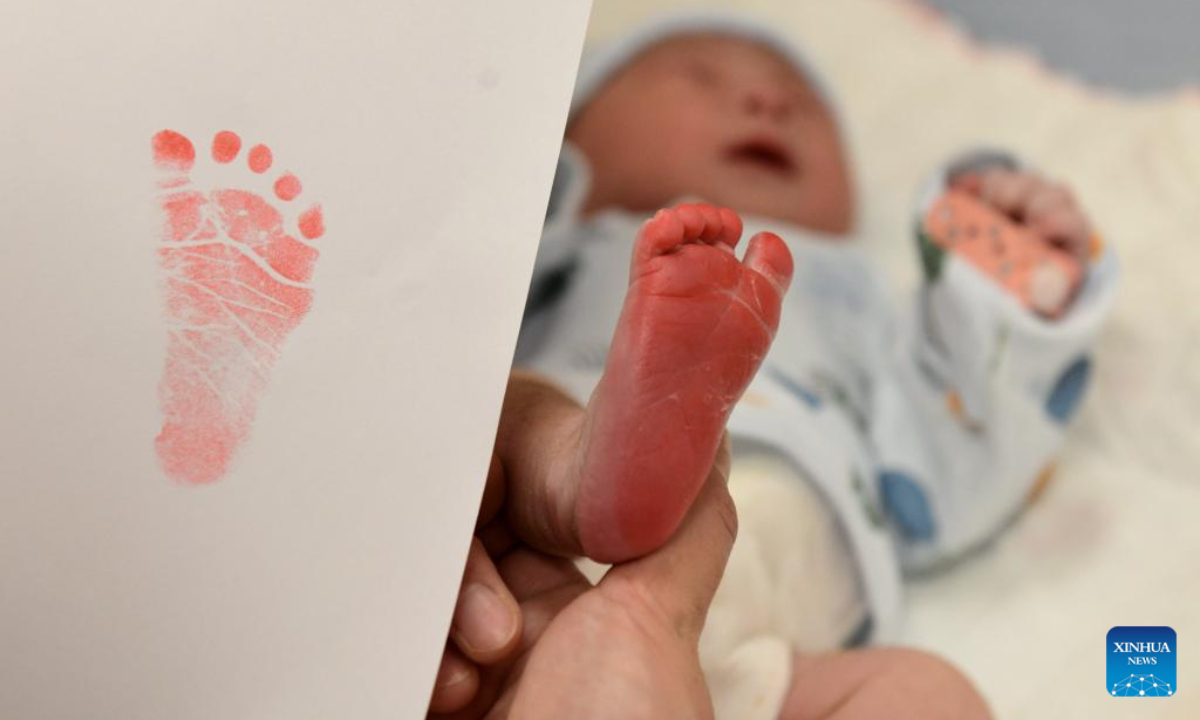
A medical worker gets a newborn baby's commemorative footprint at a hospital in Shijiazhuang, North China's Hebei Province, Jan 22, 2023. Photo:Xinhua
Multiple Chinese cities have issued supportive policies including providing subsidies for three-child families to encourage fertility, with some issuing 500 yuan ($72.63) for families raising three children each month.
Shenyang, with a population of more than nine million in Northeast China's Liaoning Province, released a plan in February to promote long-term and balanced population development. Local families with household registrations of three children will receive 500 yuan in subsidies for each month, until the third child reaches three years old, according to the Shenyang local government.
Supporting policies for housing will also be carried out. Those family having two or three children under 18-year-old who have owned two residential departments in Shenyang are allowed to purchase one more commercial department within certain areas, according to the authorities.
Along with Shenyang, some other cities including Hangzhou, Shenzhen and Ji'nan all released corresponding policies to encourage larger families. Hangzhou, capital of East China's Zhejiang Province will also issue a one-off subsidy of 20,000 yuan to local residents with three children, according to media reports.
In Ji'nan, East China's Shandong Province, two or three-child family who have child born after January 1 this year could get a subsidy of 600 yuan for each child monthly until the child reaches three years old, according to the Ji'nan local authorities.
Comprehensive measures including additional parental leave, extended maternity leave and subsidies have been widely adopted and explored in many regions across the country to encourage more births.
It mainly aims to provide service support for childbirth to build universal care service system, while supportive measures including the extension of leave and subsidies are to provide time and economic support, which are both important to "boost the confidence in childbirth," Song Jian, a demographer from the Center for Population and Development Studies of the Renmin University of China, told the Global Times on Thursday.
However, different regions should avoid comparisons, as it doesn't mean that the more money or the more leave time you give out, the better the effect will be, Song said.
For instance, long leave will weaken the competitiveness of women in the labor market, and it is not conducive to win the recognition of enterprises, on particularly in facing fierce competition, according to Song. Song suggested that a comprehensive cost-sharing mechanism should be considered to all the parties concerned, in order to avoid discrimination against women.
The detailed rules of subsidies distribution should be based on the practice of supporting measures, as well as depending on the local conditions to maximize benefits, Song said.
Data released by the National Bureau of Statistics of China (NBS) have showed that the population in the Chinese mainland recorded
negative growth for the first time in 61 years, decreasing by 850,000 in 2022.
Experts have said that negative population growth is the inevitable result of the country's long-term low fertility rate, but the country's demographic dividend will not disappear and vibrant labor forces will continue to drive economic growth.
Yu Jiadong, vice minister of human resources and social security, told a press briefing on Thursday that the number of younger labor forces is still growing. A total of 16.62 million new urban job seekers are to be expected to find employment, a record high for recent years, meaning pressure on employment is still relatively high, according to Yu.




